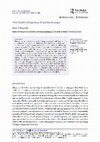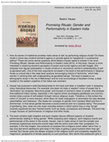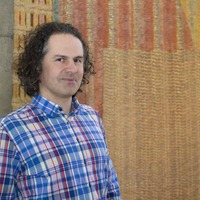Publications on Yoga by Beatrix Hauser

Anthropology & Medicine, 2021
This paper explores the capacity of yoga narratives and practices to contribute to and relate ide... more This paper explores the capacity of yoga narratives and practices to contribute to and relate ideas about health. It adds theoretically to existing literature on yoga by introducing the concept of the ‘health imaginary’ as an analytic lens for considering yoga discourses in late modern times, where personal health care and spiritual ambitions are once again becoming blurred. With this perspective, the paper provides a thorough analysis of how yoga postures (asanas) are conceived to work therapeutically, in yoga’s recent history and in present-day yoga therapy. Taking case studies from India and Germany, it is shown empirically how the application of asanas is rationalized differently in specific geographical and therapeutic environments – particularly regarding the presumed theory of the body. Thus, the concept of the health imaginary not only provides analytic space to explore the implicit logics and goals of healing in different contexts, but also offers clues about the distinct s...
Yoga in Transformation. Historical and Contemporary Perspectives. Ed. by Karl Baier et al., 2018

Yoga Traveling: Bodily Practice in Transcultural Perspective, 2013
The complete book is available for (free) download at:
https://www.asia-europe.uni-heidelberg.de... more The complete book is available for (free) download at:
https://www.asia-europe.uni-heidelberg.de/en/institute/publications.html
This book focuses on yoga’s transcultural dissemination in the twentieth
and twenty-first centuries. In the course of this process, the term “yoga” has been
associated with various distinctive blends of mental and physical exercises
performed to achieve improvement in terms of esotericism, fitness, selfactualization,
body aesthetics, or health care. This introductionary chapter surveys
the development of modern yoga studies as a new field of academic inquiry in the
humanities and social sciences. It shows how the emergence and diversity of
today’s postural yoga provides rich source material for understanding the process
of cultural diffusion and knowledge transfer. With a cursory glance at the sources
and approaches in the historical and philological study of Indian yoga the chapter
then argues that yoga never constituted a monolithic or homogenious entity. The
remaining section explores how recent ways of theorizing global spaces, transnational
flows, and cultural interactions can inspire and facilitate the analysis of
present-day yoga and its dynamics and thus provide a provisional outline for the
notion of transculturality in relation to the study of yoga’s global circulation. This
leads to a brief synopsis of the following chapters.

Yoga Traveling: Bodily Practice in Transcultural Perspective, 2013
Transcultural flows are communicated through various channels. For
most of them language is inst... more Transcultural flows are communicated through various channels. For
most of them language is instrumental in mediating and resituating cultural
meanings. Taking the case of modern Hatha Yoga, this chapter focuses on the
ways in which distinct types of tutorials contribute to the cultural translation of this
bodily practice. I explore habitual language use in yoga classes in its capacity to
shape and reformulate notions on the body, self, and well-being. This analysis
focuses on two highly standardized examples of postural yoga, both practiced in
Germany: (1) Bikram Yoga, a fairly recent and demanding form of yoga that
emphasizes extensive stretching, muscle formation, and balance, performed in a
training hall heated to forty degrees Celsius; and (2) Yoga for Everyone as promoted
by Kareen Zebroff. Her yoga instructions on television and in books can be
considered a paradigm for yoga gymnastics that in the 1970s facilitated the popularization of postural yoga in Germany and elsewhere. The comparison clearly
shows the contrasts between various types of teaching postural yoga, and also in
what respect the approach to yoga as a method of maintaining a healthy body seems
to have changed in the last decades. I argue that some of the more recent fashions of
Hatha Yoga (again) convey more than physical education; rather they call upon the
self as an agent to transgress personal and bodily limits. In a post-secular and
liberalized setting these techniques to enhance human flexibility and performance
are framed within the health discourse.

Asian Ethnology, 2016
Books General This Book assemBles sixteen essays on disseminators of modern yoga, emphasizing pos... more Books General This Book assemBles sixteen essays on disseminators of modern yoga, emphasizing posture-based yoga and also referring to recent Indian traditions of bhakti-and karma yoga. It is a welcome contribution to what has emerged in the last decade as modern yoga studies in the social sciences and the humanities. In this context, the term "modern" refers to yoga discourses and practices from the mid-nineteenth century onwards, shaped not only by ideals of science, rationalization, and secularization, but by transnational encounters of Western esotericists interested in Hinduism with the British-educated Indian elite in search for their Hindu roots and identity (De Michelis 2005). The medium of this encounter was English and, like several other Hindu concepts circulating on a global scale, the understanding of yoga was accompanied by semantic interferences as well as a new stage of re-contextualization and hybridization. Part of this process were significant changes in the kind of transmission as well as in the position and identity of yoga masters. In this volume, the contributors consider what happened "when Indian yoga gurus ... [came] to the West," framing yoga as a practical system, teaching group classes, and incorporating new technologies (2). Moreover, the authors intend to shed "new light on the changing role and function of the yoga guru in nontraditional contexts" (1). They wish to explore the status of these gurus and how Western yoga teachers negotiate their authority, last but not least in the case of guruship-related scandals and abuses. Following the oeD, the term "guru" is taken colloquially to name "a Hindu spiritual teacher or head of a religious sect," yet excluding its popular metaphorical meaning (like in "fitness guru"). Unfortunately, the editors do not relate their approach of understanding guru phenomena in modern society to earlier findings and the current state of research. They neither render recent debates on guru faith or new religious movements, nor do they consider the semantic dynamics involved in what Srinivas Aravamudan has coined "Guru English." Probably this is the reason why the contributions vary in their degree of theorizing and scope of conclusion. Most chapters describe the life and work of the respective yoga guru, at times accompanied by very personal experiences. Fortunately, some authors also share further conceptual reflections and connect their findings with earlier arguments and discourses (for example, the contribution by Joseph Alter). Moreover, although compilations like this
Books by Beatrix Hauser

Promising Rituals: Gender and Performativity in Eastern India, 2012
This book shows how the performance of rituals influences the understanding that Hindu women form... more This book shows how the performance of rituals influences the understanding that Hindu women form of their own selves, their sense of femininity, identity as well as their role and position in the lived-in world, and vice versa. Drawn from an intensive ethnographic fieldwork in southern Orissa, each section of the book takes a close look at a specific ritual practice, in exploring concepts such as purity/pollution, religious observances (such as fasting), deity possession, associated beliefs and attitudes, as also celebrated traditions such as Thākurāṇī Yātrā, the local processions, and the role of female ritual specialists.
The study uses the premise that religious practices in themselves are neither restricting nor liberating; rather rituals provide a perceptual context with the ability to affect the self-understanding of participants, and their conception of agency, in a way that spills across non-ritual spheres. Conceptualizing gender identity as resulting from seen, but mostly unnoticed, everyday activities and approaching cultural performances as sites of collectively defining the self, the author offers a telling and vivid account of how women perceive, realize and reflect on religious ideas, while engaging in rituals and, by doing so, negotiate complex gender norms. The book also examines the assumptions of recent theories on the social construction of identities, often-debated impact of religion on women, performativity and ritual agency in the ‘doing’ of gender in a traditional, non-Western context.
This book will serve as essential reading for scholars of sociology, anthropology, gender studies, cultural studies, history, religion, performance, and folklore studies.

Intersections: Gender and Sexuality in Asia and the Pacific, 2016
ISBN-978-0-415-62585-2, xix + 277 reviewed by Ishita Shruti 1. How do women of traditional societ... more ISBN-978-0-415-62585-2, xix + 277 reviewed by Ishita Shruti 1. How do women of traditional societies make sense of self, by performing religious rituals? Do these rituals in some way constrict women's agency or provide space for 'bargaining' in a patriarchal setting? These are some central questions which Beatrix Hauser seeks to answer in her book Promising Rituals: Gender and Performativity in Eastern India (2012). In this book, Hauser is more interested in exploring women's perception of power and human agency and self images. She analyses how regular participation in rituals construct or reconstruct women's understanding of self (a gendered self). One of the main arguments conveyed in the book is that performance in religious rituals (a cultural site in the case here) produce 'encouraging notions of femininity,' which help women in verifying their self-understanding as gendered beings. The book is based on an ethnographic study in the city of Behrampur and its rural surroundings of Southern Orrisa, a state located on the eastern coastline of the Indian sub-continent. 2. Hauser has produced a solid theoretical base for the book and taken a 'subaltern' path in analysing many theoretical discourses. For example, she does not imply a 'western' notion of power that is 'domination' but analyses 'discursive power' and focuses on women's views on power. She stresses that traditional Indian society, especially in the regions where worshipping goddesses are common, women draw a sense of self esteem through various religious rituals. Therefore, in this context the notion of 's(h)akti' is more relevant, which does not mean subjugation or domination but also denotes 'potentialities' and 'tolerance.' She draws her concepts on gender from Candace West and Don H. Zimmerman. In that sense gender becomes a social construct and not a 'passive being.' The process of gendering, then, does not only mean everyday actions in which actors may or may not get involved cognitively but also 'framed events' such as rituals, processions and festivals. The book has a major focuses on 'performances' of religious and other rituals.
Journal of the Royal Anthropological Institute, 2014
Contributions to Indian Sociology, 2014
Mit irdischem Schaudern und göttlicher Fügung: Bengalische Erzähler und ihre Bildvorführungen, 1998
Die Potua, eine Kaste professioneller Erzähler im indischen Bundesstaat Westbengalen, ziehen von ... more Die Potua, eine Kaste professioneller Erzähler im indischen Bundesstaat Westbengalen, ziehen von Ort zu Ort und tragen Geschichten vor, die sie mit Bildrollen illustrieren. Dabei singen sie zum Beispiel von der frommen Behulā, dem Rāmāyana, Kṛṣṇas erotischen Streichen, von schaurig-sensationellen Begebenheiten, aber auch vom Nutzen der Alphabetisierung.
In einer "dichten Beschreibung" verwebt die Autorin ethnologische Interpretationen mit Lebensansichten der Erzähler, Liedversen und historischen Daten zu einem Gesamtbild dieser Erzählkultur. Sie untersucht den zeitgenössischen Kontext und die Bedeutung dieses Bildvorführens und analysiert die Erzählereignisse sowohl in künstlerischer Hinsicht als auch in ihrer Bedeutung als Erwerbstätigkeit der Potua.
(Zugl.: Hamburg, Univ. Diss., 1998)
Religious Studies Review, 1999
Publications on Various Subjects by Beatrix Hauser
Dialogues with Gods: Possession in Middle Indian Rituals, ed. by Tina Otten & Uwe Skoda, 2014
How Purity is Made, ed. by Petra Rösch & Udo Simon, 2012
Masken der Vorzeit in Europa, ed. by Harald Meller & Regina Maraszek, 2012
Erwägen, Wissen, Ethik (EWE), Apr 21, 2012
Centres Out There? Facets of Subregional Identities, ed. by Hermann Kulke & Georg Berkemer, 2011
Reinheit, ed. by Peter Burschel & Christoph Marx, 2011
Ritual Dynamics and the Science of Religion, Vol. II, ed. by Axel Michaels et al., 2010
Representation Matters: (Re)Articulating Collective Identities in a Postcolonial World, ed. by Anette Hoffmann & Esther Peeren, 2010









Uploads
Publications on Yoga by Beatrix Hauser
https://www.asia-europe.uni-heidelberg.de/en/institute/publications.html
This book focuses on yoga’s transcultural dissemination in the twentieth
and twenty-first centuries. In the course of this process, the term “yoga” has been
associated with various distinctive blends of mental and physical exercises
performed to achieve improvement in terms of esotericism, fitness, selfactualization,
body aesthetics, or health care. This introductionary chapter surveys
the development of modern yoga studies as a new field of academic inquiry in the
humanities and social sciences. It shows how the emergence and diversity of
today’s postural yoga provides rich source material for understanding the process
of cultural diffusion and knowledge transfer. With a cursory glance at the sources
and approaches in the historical and philological study of Indian yoga the chapter
then argues that yoga never constituted a monolithic or homogenious entity. The
remaining section explores how recent ways of theorizing global spaces, transnational
flows, and cultural interactions can inspire and facilitate the analysis of
present-day yoga and its dynamics and thus provide a provisional outline for the
notion of transculturality in relation to the study of yoga’s global circulation. This
leads to a brief synopsis of the following chapters.
most of them language is instrumental in mediating and resituating cultural
meanings. Taking the case of modern Hatha Yoga, this chapter focuses on the
ways in which distinct types of tutorials contribute to the cultural translation of this
bodily practice. I explore habitual language use in yoga classes in its capacity to
shape and reformulate notions on the body, self, and well-being. This analysis
focuses on two highly standardized examples of postural yoga, both practiced in
Germany: (1) Bikram Yoga, a fairly recent and demanding form of yoga that
emphasizes extensive stretching, muscle formation, and balance, performed in a
training hall heated to forty degrees Celsius; and (2) Yoga for Everyone as promoted
by Kareen Zebroff. Her yoga instructions on television and in books can be
considered a paradigm for yoga gymnastics that in the 1970s facilitated the popularization of postural yoga in Germany and elsewhere. The comparison clearly
shows the contrasts between various types of teaching postural yoga, and also in
what respect the approach to yoga as a method of maintaining a healthy body seems
to have changed in the last decades. I argue that some of the more recent fashions of
Hatha Yoga (again) convey more than physical education; rather they call upon the
self as an agent to transgress personal and bodily limits. In a post-secular and
liberalized setting these techniques to enhance human flexibility and performance
are framed within the health discourse.
Books by Beatrix Hauser
The study uses the premise that religious practices in themselves are neither restricting nor liberating; rather rituals provide a perceptual context with the ability to affect the self-understanding of participants, and their conception of agency, in a way that spills across non-ritual spheres. Conceptualizing gender identity as resulting from seen, but mostly unnoticed, everyday activities and approaching cultural performances as sites of collectively defining the self, the author offers a telling and vivid account of how women perceive, realize and reflect on religious ideas, while engaging in rituals and, by doing so, negotiate complex gender norms. The book also examines the assumptions of recent theories on the social construction of identities, often-debated impact of religion on women, performativity and ritual agency in the ‘doing’ of gender in a traditional, non-Western context.
This book will serve as essential reading for scholars of sociology, anthropology, gender studies, cultural studies, history, religion, performance, and folklore studies.
In einer "dichten Beschreibung" verwebt die Autorin ethnologische Interpretationen mit Lebensansichten der Erzähler, Liedversen und historischen Daten zu einem Gesamtbild dieser Erzählkultur. Sie untersucht den zeitgenössischen Kontext und die Bedeutung dieses Bildvorführens und analysiert die Erzählereignisse sowohl in künstlerischer Hinsicht als auch in ihrer Bedeutung als Erwerbstätigkeit der Potua.
(Zugl.: Hamburg, Univ. Diss., 1998)
Publications on Various Subjects by Beatrix Hauser
https://www.asia-europe.uni-heidelberg.de/en/institute/publications.html
This book focuses on yoga’s transcultural dissemination in the twentieth
and twenty-first centuries. In the course of this process, the term “yoga” has been
associated with various distinctive blends of mental and physical exercises
performed to achieve improvement in terms of esotericism, fitness, selfactualization,
body aesthetics, or health care. This introductionary chapter surveys
the development of modern yoga studies as a new field of academic inquiry in the
humanities and social sciences. It shows how the emergence and diversity of
today’s postural yoga provides rich source material for understanding the process
of cultural diffusion and knowledge transfer. With a cursory glance at the sources
and approaches in the historical and philological study of Indian yoga the chapter
then argues that yoga never constituted a monolithic or homogenious entity. The
remaining section explores how recent ways of theorizing global spaces, transnational
flows, and cultural interactions can inspire and facilitate the analysis of
present-day yoga and its dynamics and thus provide a provisional outline for the
notion of transculturality in relation to the study of yoga’s global circulation. This
leads to a brief synopsis of the following chapters.
most of them language is instrumental in mediating and resituating cultural
meanings. Taking the case of modern Hatha Yoga, this chapter focuses on the
ways in which distinct types of tutorials contribute to the cultural translation of this
bodily practice. I explore habitual language use in yoga classes in its capacity to
shape and reformulate notions on the body, self, and well-being. This analysis
focuses on two highly standardized examples of postural yoga, both practiced in
Germany: (1) Bikram Yoga, a fairly recent and demanding form of yoga that
emphasizes extensive stretching, muscle formation, and balance, performed in a
training hall heated to forty degrees Celsius; and (2) Yoga for Everyone as promoted
by Kareen Zebroff. Her yoga instructions on television and in books can be
considered a paradigm for yoga gymnastics that in the 1970s facilitated the popularization of postural yoga in Germany and elsewhere. The comparison clearly
shows the contrasts between various types of teaching postural yoga, and also in
what respect the approach to yoga as a method of maintaining a healthy body seems
to have changed in the last decades. I argue that some of the more recent fashions of
Hatha Yoga (again) convey more than physical education; rather they call upon the
self as an agent to transgress personal and bodily limits. In a post-secular and
liberalized setting these techniques to enhance human flexibility and performance
are framed within the health discourse.
The study uses the premise that religious practices in themselves are neither restricting nor liberating; rather rituals provide a perceptual context with the ability to affect the self-understanding of participants, and their conception of agency, in a way that spills across non-ritual spheres. Conceptualizing gender identity as resulting from seen, but mostly unnoticed, everyday activities and approaching cultural performances as sites of collectively defining the self, the author offers a telling and vivid account of how women perceive, realize and reflect on religious ideas, while engaging in rituals and, by doing so, negotiate complex gender norms. The book also examines the assumptions of recent theories on the social construction of identities, often-debated impact of religion on women, performativity and ritual agency in the ‘doing’ of gender in a traditional, non-Western context.
This book will serve as essential reading for scholars of sociology, anthropology, gender studies, cultural studies, history, religion, performance, and folklore studies.
In einer "dichten Beschreibung" verwebt die Autorin ethnologische Interpretationen mit Lebensansichten der Erzähler, Liedversen und historischen Daten zu einem Gesamtbild dieser Erzählkultur. Sie untersucht den zeitgenössischen Kontext und die Bedeutung dieses Bildvorführens und analysiert die Erzählereignisse sowohl in künstlerischer Hinsicht als auch in ihrer Bedeutung als Erwerbstätigkeit der Potua.
(Zugl.: Hamburg, Univ. Diss., 1998)